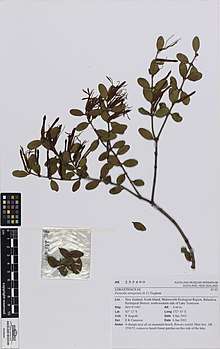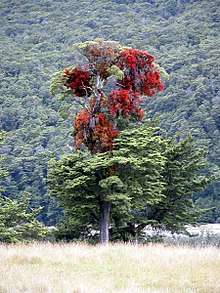Peraxilla tetrapetala
Peraxilla tetrapetala, or red mistletoe, is a parasitic plant in the family Loranthaceae, endemic to New Zealand and found on both the North and South Islands.[3] The Māori names for the plant are pikirangi, pirirangi and roeroe.[2]
| Peraxilla tetrapetala | |
|---|---|
 | |
| Scientific classification | |
| Kingdom: | Plantae |
| Clade: | Tracheophytes |
| Clade: | Angiosperms |
| Clade: | Eudicots |
| Order: | Santalales |
| Family: | Loranthaceae |
| Genus: | Peraxilla |
| Species: | P. tetrapetala |
| Binomial name | |
| Peraxilla tetrapetala | |
It is a shrub up to one metre tall with glabrous leaves. The flowers are 4–5 mm long, bright red to orange in colour which split open to the base. Red mistletoe mainly parasitises Quintinia and Nothofagus species.[4] Its principle host is the black/mountain beech (Nothofagus solandri complex). However, north of latitude 38°S this species utilises tawheowheo (Quintinia serrata), and in the far north has been found on pohutukawa (Metrosideros excelsa), puriri (Vitex lucens) and towai (Weinmannia silvicola), and hence, is the most widely distributed beech mistletoe.[3]
P. tetrapetala is hermaphroditic, self-compatible, and is both bird-pollinated and bird-dispersed, yet has an explosive bud-opening mechanism.[5] It is thought that birds are more important for seed dispersal than for pollination.[5]
The caterpillar of the endemic moth Zelleria maculata feeds on the inside flower buds of P. tetrapetala.[6]
Conservation
The plant is highly palatable to the introduced common brushtail possum resulting in a threat to the plant population.[3] The possum browsing effect appears more important in the North Island than in the South Island, where the major cause of foliage browse has been attributed to insect attack.[7] A continued major threat is habitat loss.[3]
Red mistletoe is listed as in "Gradual Decline" in the New Zealand Threat Classification System and relies on conservation measures to halt the decline.[1]

References
- Rod Hitchmough, Leigh Bull and Pam Cromarty (compilers). New Zealand Threat Classification System lists - 2005. Wellington: Department of Conservation. ISBN 0-478-14128-9. Retrieved 17 April 2009.
- "Peraxilla tetrapetala". www.nzflora.info. Landcare Research New Zealand Ltd. Retrieved 15 January 2017.
- de Lange, P.J., Norton, D.A., Molloy, B.P. 1997. "New Zealand's loranthaceous mistletoes" (PDF). Proceedings of a workshop hosted by Threatened Species Unit, Department of Conservation, Cass, 17 – 20 July 1995
- Allan, H. H. (1982). Flora of New Zealand. I. Botany Division, Department of Scientific and Industrial Research. Retrieved 17 April 2009.
- Ladley J.J. 1997. Reproductive Ecology of the Loranthaceae mistletoes of New Zealand, Pp. 111–114, in "Proceedings of a workshop hosted by Threatened Species Unit, Department of Conservation, Cass, 17 – 20 July 1995" (PDF).
- Dave Kelly; Jenny J. Ladley; Alastair W. Robertson; Lisa Crowfoot (8 October 2008). "Flower predation by Zelleria maculata (Lepidoptera) on Peraxilla mistletoes: effects of latitude and fragmentation, and impact on fruit set" (PDF). New Zealand Journal of Ecology. 32 (2). Retrieved 15 January 2017.
- Ladley J.J. 1994. Reproductive Ecology of the Loranthaceae mistletoes of New Zealand. Unpublished M.Sc. Thesis, University of Canterbury, Christchurch.
External links
| Wikimedia Commons has media related to Peraxilla tetrapetala. |
- Department of Conservation - mistletoe page
- University of Canterbury - mistletoe photographs
- Citizen science observations of Peraxilla tetrapetala.
